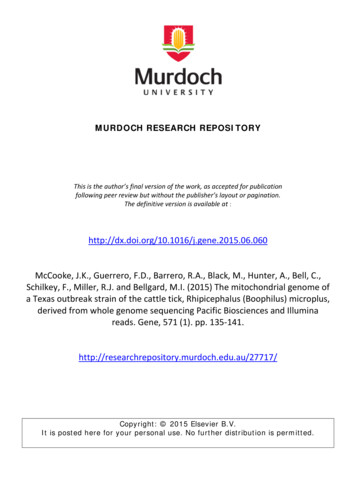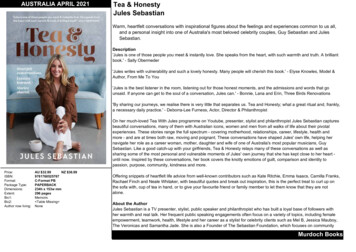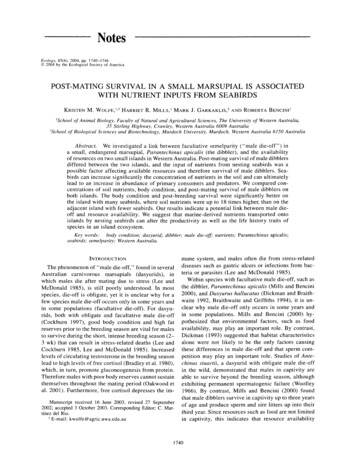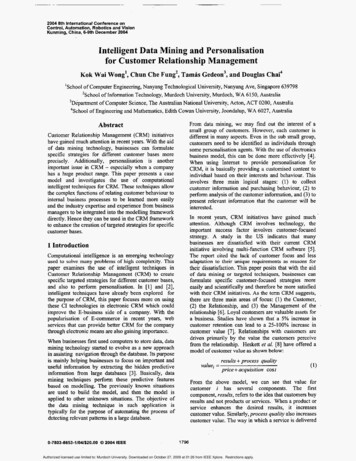
Transcription
MURDOCH RESEARCH REPOSITORYThis is the author’s final version of the work, as accepted for publicationfollowing peer review but without the publisher’s layout or pagination.The definitive version is available at ke, J.K., Guerrero, F.D., Barrero, R.A., Black, M., Hunter, A., Bell, C.,Schilkey, F., Miller, R.J. and Bellgard, M.I. (2015) The mitochondrial genome ofa Texas outbreak strain of the cattle tick, Rhipicephalus (Boophilus) microplus,derived from whole genome sequencing Pacific Biosciences and Illuminareads. Gene, 571 (1). pp. 7717/Copyright: 2015 Elsevier B.V.It is posted here for your personal use. No further distribution is permitted.
ACCEPTED MANUSCRIPTThe mitochondrial genome of a Texas outbreak strain of the cattle tick,Rhipicephalus (Boophilus) microplus, derived from whole genome sequencingRIPTPacific Biosciences and Illumina reads.John K. McCooke a, Felix D. Guerrero b , Roberto A Barrero a, Michael Black a, AdamNUSCHunter a, Callum Bell c, Faye Schilkey c, Robert J Miller d, Matthew I Bellgard a, cCentre for Comparative Genomics, Murdoch University, Murdoch, AustraliabUnited States Department of Agriculture, Agricultural Research Service, Knipling-MAaBushland U. S. Livestock Insects Research Laboratory, Kerrville, USANational Center for Genome Resources, Santa Fe, NM, USAdUnited States Department of Agriculture, Agricultural Research Service, CattleTEDcACCEPFever Tick Research Laboratory, Edinburg, USA Corresponding Author:Felix D. -830-792-0314 FAXWorking title: Assembly of Rhipicephalus microplus mitogenomeKeywords: Cattle Tick, mitochondrial genome, Pac Bio
ACCEPTED MANUSCRIPT2AbstractThe cattle fever tick, Rhipicephalus (Boophilus) microplus is one of the mostPTsignificant medical veterinary pests in the world, vectoring several serious livestockRIdiseases negatively impacting agricultural economies of tropical and subtropicalcountries around the world. In our study, we assembled the complete R. microplusSCmitochondrial genome from Illumina and Pac Bio sequencing reads obtained fromNUthe ongoing R. microplus (Deutsch strain from Texas, USA) genome sequencingproject. We compared the Deutsch strain mitogenome to the mitogenome from aMABrazilian R. microplus and from an Australian cattle tick that has recently beentaxonomically designated as Rhipicephalus australis after previously beingTEDconsidered R. microplus. The sequence divergence of the Texas and Australia ticks ismuch higher than the divergence between the Texas and Brazil ticks. This isACCEPconsistent with the idea that the Australian ticks are distinct from the R. microplus ofthe Americas.
ACCEPTED MANUSCRIPT31. IntroductionPTThe cattle tick, Rhipicephalus (Boophilus) microplus is a significant pest ofRIcattle in tropical and subtropical regions of the world. The economic impact of thisectoparasite has been estimated to be 3.2 US billion annually in Brazil alone (GrisiSCet al., 2014). The huge economic toll this tick places upon the agricultural economyNUof many countries has driven efforts to discover effective control measures thatcattle producers can implement to maximize the productivity of their livestockMAoperations. Current control methods rely almost exclusively upon chemicalacaricides and tick populations have developed multiple mechanisms of acaricideTEDresistance to overcome this control method. Emerging DNA technologies have madesequencing the complex cattle tick genome a possibility and the ongoing project toACCEPsequence the genome of the Texas outbreak strain of R. microplus, designated theDeutsch strain, is hosted at CattleTickBase (Bellgard et al., 2012). As an earlyoutcome of this sequencing project, mitochondrial gene sequences from the Deutschstrain were obtained from data generated by both Pacific Biosciences- and Illuminabased sequencing protocols. We report the complete mitochondrial sequence of theDeutsch Texas strain of R. microplus. This is the first complete mitochondrialsequence from a North American population of cattle tick. The long Pac Bio readsenabled us to resolve the sequence of the variable tandem repeat region of themitochondrial genome that had proven difficult to determine in earlier studiesbased on Sanger (Campbell et al., 1999) or short read (Burger et al., 2014)technologies. Comparisons between the Deutsch tick mitogenome and those from
ACCEPTED MANUSCRIPT4Brazil and Australia reveal a much closer relationship between the Texas andBrazilian cattle ticks than the Texas and Australian cattle ticks. Our findings arePTconsistent with the molecular phylogenetic analysis by Burger et al. (2014) and ourRITexas tick strain is apparently from their study's R. microplus Clade A. Our resultsalso add support for the recent reclassification of R. microplus populations fromNUSCAustralia to Rhipicephalus australis (Estrada-Pena et al., 2012).MA2. Materials and MethodsTED2.1. Source of tick materialsGenomic DNA was extracted from eggs of the Deutsch strain of R. microplus.ACCEPThis strain has been maintained in colony at the Cattle Fever Tick ResearchLaboratory, Edinburg, TX since its collection during an outbreak in South Texaswhich occurred in 2001 (Davey et al., 1980). Tick eggs are collected at eachgeneration and frozen and stored at -80oC as part of our laboratory tick-rearingprotocols. The frozen eggs from the f7, f10, f11, and f12 generation collectionsserved as the source of genomic DNA. The strain was started from only a fewengorged females and has been inbred since its collection, but is not geneticallyhomogeneous. Eggs from this group of 50 females were pooled in a petri plate,mixed with a flat spatula, and weighed into vials to contain a final amount ofapproximately 3 g each.
ACCEPTED MANUSCRIPT52.2. DNA SequencingPTA total of 10 g of tick eggs was used to extract very high molecular weightRIgenomic DNA following the protocol from Sambrook et al. (1989). The extractionprotocol consists of grinding material in aqueous buffer, RNAse treatment, digestionSCby proteinase K, phenol extraction, followed by 4 d of dialysis in 50 mM Tris, 10 mMNUEDTA, pH 8.0 dialysis buffer, changing buffer twice daily. A total of 15.6 mg ofgenomic DNA was recovered and stored at 4 oC. RNA-free status, DNA size andMAintegrity were verified by agarose gel electrophoresis and the size was determinedto be 200kb (Guerrero et al., 2010). A portion of the genomic DNA was processedTEDby Cot filtration as described in Guerrero et al. (2010) to a Cot cloning value of 69.6M. s. (Lamoureux et al., 2005) to enrich for single, low copy, and moderatelyACCEPrepetitive DNAs. Input DNA for both the Pacific Biosciences and Illumina sequencingwas quality checked for quantity and size using a Qubit fluorometer (LifeTechnologies, Grand Island, NY, USA) and Agilent Bioanalyzer (Agilent Technologies,Santa Clara, CA, USA).The Pacific Biosciences sequencing was performed at National Center forGenome Resources (Santa Fe, NM, USA). Two μg of genomic DNA (not Cot-selected)was sheared to 8kb with the Covaris G-tube according to manufacturer'sinstructions (Covaris Inc., Woburn, MA, USA). Five DNA libraries were preparedaccording to the Pacific Biosciences low-input 10kb library preparation andsequencing protocol which includes DNA damage repair, end repair, SMRTbelladapter ligation, and an exonuclease step to remove failed ligation products. The
ACCEPTED MANUSCRIPT6libraries were sequenced on 178 SMRT cells using C2 chemistry and XL polymerase,yielding 10,499,989 reads with a minimum length of 1 kb, representingPT31,054,642,957 bases. The average and median read length was 2,957 bases andRI2,234 bases, respectively. The longest read was 26, 364 bases. Overall, the Pac Bioreads represent 4X coverage of the cattle tick genome.SCThe Illumina-based sequencing was performed at the National Center forNUGenome Resources (Santa Fe, NM, USA) using the standard Illumina DNA librarypreparation protocol. The TruSeq DNA Sample Preparation V2 kit (Illumina, CA,MAUSA) was used to generate sequencing libraries from the Cot-selected genomic DNAdescribed above. Two g of DNA was fragmented using the Covaris S2 systemTEDaccording to the manufacturer's protocol (Covaris Inc.). The resulting overhang ofthe dsDNA fragments was end-repaired with the End Repair Mix of the V2 kit byACCEPincubating at 30 C for 30 min. The polished fragments were then phosphorylated byT4 polynucleotide kinase, followed by the addition of a single A nucleotide to the 3′end by incubating the end repaired fragments with A-Tailing mix at 37 C for 30min.The fragment-adapter ligation occurred at 30 C for 10 min, after which the ligatedproduct was size-selected by gel electrophoresis, the library fragment range wasvisualized under brief ultraviolet light and the desired size range of 300-400 bpexcised and subjected to a final PCR amplification step of 10 cycles. All amplifiedlibraries were quantitatively and qualitatively assessed by Nanodrop ND-1000(Thermo Scientific, DE, USA) and DNA bioanalyzer 2100 (Agilent, CA, USA),respectively. The Cot-selected genomic DNA library was sequenced as 100 nt-pairedends on three lanes in a flowcell using HiSeq2000. Following sequencing, the raw
ACCEPTED MANUSCRIPT7reads were processed by the Illumina pipeline and further by the NCGR contaminantfiltering pipeline to remove adapter dimers, PCR primers, unused indexes, andPTIllumina PhiX control sequences, among others. This process yielded approximatelyRI185 million high-quality reads per lane for a total of approximately 555 millionSCreads and 111 billion bases.NU2.3 BioinformaticsMATo de novo assemble the R. microplus mitochondrial genome, we firstidentified conserved mitochondrial sequence motifs by the comparison ofTEDRhipicephalus sanguineus (NC 002074), Haemaphysalis flava (NC 005292) andAmblyomma triguttatum (NC 005963) mitochondrial sequences sourced from NCBIACCEP(www.ncbi.nlm.nih.gov), as these tick mitochondria share a common genomeorganization. At the time of our analysis, these were the most complete tickmitochondrial genomes available for public download at NCBI. Conservedmitochondrial sequence motifs were then used to retrieve Illumina reads from theCot-selected DNA sequence dataset (described above) with sequence similarity tothe mitochondrial genome (Langmead and Salzberg, 2012). Mitochondrial genomeenriched Illumina reads were de novo assembled using Velvet (Zerbino and Birney,2008) with an optimal k-mer size determined using VelvetOptimizer set to iterateover a k-mer range from 31 to 63 with a step of 4. Assembled Illumina contigs wereinitially validated against the R. sanguineus genome. To further extend the R.microplus mitochondrial genome coverage, we used the Illumina assembled contigs
ACCEPTED MANUSCRIPT8to identify raw Pacbio reads with sequence similarity to validated mitochondrialcontigs. These raw Pacbio reads were error-corrected using LSC 1.alpha (Au et al.,PT2012) and then utilized to resolve repeats within the R. microplus TexasRImitochondrial genome.ClustalW from the MacVector 12.7.5 software suite (MacVector, Inc., Cary,SCNC, USA) was used to align the the mitochondrial genomes of R. microplus BrazilNU(GenBank Accession No. KC503261), R. microplus Cambodia (GenBank Accession No.KC503260), R. microplus China (GenBank Accession No. KC503259), R. australisMA(GenBank Accession No. KC503255), R. microplus Texas (this study, GenBankAccession No. KP143546), and a partial mitochondrial genome of RhipicephalusTEDannulatus Romania (GenBank Accession No. KC503256), using a gap penalty of 10.0,an extend gap penalty of 5.0, a delay divergent of 40%, and weighted transitions.ACCEPThe phylogram was constructed from the ClustalW using MacVector and NeighborJoining with 1000 reps in Bootstrap mode, the Tamura-Nei distance setting, andignoring all gaps. Custom Blast datasets were created using BLAST version 2.2.29(http://blast.ncbi.nlm.nih.gov; Altschul et al., 1990). The tRNA predictions weredone with Aragorn at parameters of -t -mt -gcinvert -seq -fasta -jr4 -o (Laslett andCanback, 2004). MITOS was also used for tRNA prediction confirmation (Bernt et al.,2013). For conceptual translations of open reading frames, the MacVector 12.7.5software suite was used (MacVector, Inc.) with the invertebrate mitochondrialcodon table.The ratio of nonsynonymous (Ka) and synonymous (Ks) substitution rates(Ka/Ks) between R. microplus and R. australis mitochondrial genes was calculated
ACCEPTED MANUSCRIPT9with the KaKs Calculation v2.0 ator2). A maximum likelihood approachPTwas taken with optimal model selection for each gene via Akaike informationRIcriterion corrected for finite sample sizes. Preliminary Needleman-Wunsch globalpairwise alignment was performed with the needle algorithm from EMBOSS toolsSCwith FASTA format output. This output was adjusted to the required axt format forNUKaks Calculation 2.0 and Ka/Ks values graphed according to gene order in the tickMAmtDNA genome.TED3. Results and Discussion3.1. Sequencing and de novo assembling the mitogenomeACCEPThe complete mitochondrial genome of the Deutsch strain of R. micropluswas assembled via a combination of sequence sources and assembly approaches(GenBank Accession No. KP143546; Supplemental File 1). Unselected and Cotselected genomic DNA were used as the template for Pac Bio and Illuminasequencing, respectively. As our first step, the mitochondrial sequences of R.sanguineous, H. flava and A. triguttatum were obtained from GenBank and aligned todetermine regions of conservation between these three species from differentmetastriate tick genera. Sequence regions greater than 7 continuous bases that werestrictly conserved between the 3 species were used to extract reads with sequenceidentity from the 100 nt paired-end Cot-selected genomic DNA sequence data set(Guerrero et al. 2010). This step created a mitochondrial sequence-enriched paired
ACCEPTED MANUSCRIPT10end sequence data set. We used this data set and bowtie2 to perform our initialassembly of the cattle tick mitochondrial genome, aligning to the R. sanguineousPTmitochondrial genome as a reference. An allowed alignment error of 22% was usedRIfor the initial alignment and an initial consensus sequence from the alignment wasgenerated using a 75% base call identity. All gaps and N’s were removed, however,SCthe length of the initial consensus sequence was not trimmed and was used at a laterNUstage to circularize the sequence. The initial consensus sequence was used toreanalyze with a new iteration under more restrictive parameters, producing a newMAalignment. A total of 6 iterations of consensus calling and correcting was used togenerate the final consensus sequence. Upon each iteration, the allowed mismatchTEDratio was reduced by 4 mismatches until a final alignment allowing 2 mismatcheswas achieved. After the final iteration, a total of 60-80 million Illumina reads (countACCEPwas different for each iteration number and the percentage of mismatch allowed)aligned to the reference R. sanguineous mitogenome and the final assemblyconsisted of 20 mitochondrial genome sequence contigs which coveredapproximately 72% of the mitochondrial genome. These 20 contigs were used tosearch CattleTickBase (Bellgard et al., 2012) for sequences with nucleotide identity.CattleTickBase is a database containing all the sequences from the R. microplusgenome sequencing project (presently at 4X coverage with Pac Bio) and wouldinclude mitochondrion-derived sequences from the Deutsch Texas cattle tickstudied here. Following this process, the entire set of the 20 contigs and the newsequences identified from CattleTickBase were reassembled. The resulting assembly
ACCEPTED MANUSCRIPT11covered approximately 80% of the mitochondrial genome when compared to the R.sanguineus reference mitogenome.PTThe final stage involved using the 20 contigs from the Illumina-derived dataRIset to screen Pac Bio sequence reads. Ninety-six Pac Bio reads were identified withsignificant sequence identity to the 20 Illumina mitochondrial contigs representingSCapproximately 14X coverage of the mitochondrial genome. Because of the relativelyNUhigh error rate of Pac Bio sequences, we aligned the Pac Bio and Illumina reads andused the Illumina reads to error-correct the Pac Bio sequences. Forty-eight of theMAPac Bio reads could be corrected with a confidence/coverage score 0.90 and thesewere used along with manual curation to complete the final mitochondrial genomeTEDsequence alignment and assembly. The resulting sequence was circularized tocreate the final mitochondrial genome sequence of R. microplus Deutsch TexasACCEP(GenBank Accession No. KP143546).3.2. Annotation of the Texas R. microplus mitogenomeThe complete mitochondrial genome of the Deutsch strain of R. micropluswas annotated using the R. sanguineous, H. flava and A. triguttatum annotation filesas a template. The annotated sequence is depicted in Figure 1 and given in detail inSupplemental File 2. The gene number and the order of features (genes , RNAs,control regions, and other miscellaneous regions) is conserved as compared withthe recently sequenced R. microplus Brazil sample and R. australis from Australia(Burger et al., 2014). The complete sequence length of R. microplus Texas is 15,167bp and contains a variable tandem repeat region consisting of a “tRNA-Glu” and a
ACCEPTED MANUSCRIPT12“similar to NAD1” motif (Fig. 2 and 3) that is repeated 4 and 3 times, respectively.This region in the Deutsch Texas R. microplus mitogenome consists of nt 5892-6156PTand is flanked by tRNA-Ser and the ND1 gene. By contrast, Burger et al. (2014)RIreported an inability to discern the number of repeats in this variable tandemrepeat region of R. australis due to their sequence data originating from short readSCsequencing technology that has a PCR step in the sample preparation protocol.NUCampbell et al. (2001) reported that PCR can introduce extra copies of templaterepeat regions during the amplification process, probably during the annealing step.MAHowever, our mitogenome sequence can definitively resolve the variable tandemrepeat region because we have individual Pac Bio reads that span the entire 265 bpTEDregion. Additionally, PCR amplification is not part of the Pac Bio protocol. In theCattleTickBase Pac Bio dataset, we found 1 Pac Bio read that completely spannedACCEPthe variable tandem repeat region and 2 Pac Bio reads that partially spanned thisregion. Following error correction, the mitogenome reads alignment allowed thedefinitive identification of the number of “tRNA-Glu” and “similar to NAD1” motifs inthe Texas cattle tick.3.3. Comparison of the Texas R. microplus mitogenome to R. australisThe recent reclassification of R. microplus populations from Australia to R.australis (Estrada-Pena et al., 2012), coupled with the phylogenetic analyses ofBurger et al. (2014) and our definitive sequence through the variable tandem repeatregion, led us to compare the gene coding regions of the mitogenomes of Texas R.microplus to the R. australis. We also included the mitogenomes from R. microplus
ACCEPTED MANUSCRIPT13populations in Brazil, Cambodia, and China to examine possible variation between R.microplus from several continents (Supplemental File 3). Over the entirePTmitogenomes in the ClustalW alignment, 99.9 % of the Brazilian and CambodianRIcattle tick nucleotides have identical aligned nucleotides in the Texas cattle tick,while 96.0 % of the Australian cattle tick (R. australis) nucleotides have identicalSCaligned nucleotides in the Texas tick (Table 1). We also aligned the partial genomeNUsequence from the related cattle tick, Rhipicephalus annulatus (GenBank AccessionNo. KC503256), and found 95.0 % nucleotide identity over the region available toMAalign. Interestingly, the R. microplus from China seems to possess a similar level ofmitogenome sequence divergence (6%) as R. annulatus when compared to the TexasTEDR. microplus mitogenome. The phylogenetic relationships (Fig. 4) between thevarious Rhipicephalus cattle ticks reflect those reported by Burger et al. (2014). InACCEPthat study, phylogenetic analyses based on both the cox1 and 16S rRNA suggestedthat the China Clade B R. microplus (included in our Fig. 4) was likely a crypticspecies within the existing R. microplus complex. Also, using this general measure,the Australian cattle tick appears to be a different species from the cattle ticks fromTexas, Cambodia, and Brazil.From the ClustalW alignment of the Texas, Brazilian, and Australian cattleticks, we identified 401 and 9 synonymous nucleotide changes in the gene codingregions comparing the Texas mitogenome to that of the cattle tick from Australiaand Brazil, respectively. We also identified 112 and 3 nonsynonymous nucleotidechanges in the gene coding regions comparing the Texas mitogenome and that fromAustralia and Brazil, respectively (Supplemental File 4). The total of 513 and 12
ACCEPTED MANUSCRIPT14overall nucleotide differences equate to differences of 3.38% and 0.08% betweenthe Texas and Australian and the Texas and Brazilian cattle tick mitogenome genePTcoding regions, respectively. The nonsynonymous changes between the three cattleRIticks are diagrammatically represented in Figure 5. Visual examination of Figure 5and a check of a non-synonymous/synonymous ratio adjusted by gene lengthSC(Supplemental File 4) indicated a non-uniform mutational rate in the genes.NUNucleotide differences between the Australian mitogenome and the two from theAmericas seem to be concentrated within the ATP6, ATP8, ND1, and C-terminal halfMAof the ND5 genes. The ND2 and Cox1 genes appear to be less affected by nucleotidesubstitutions, as they had only 6 and 1 nonsynonymous nucleotide difference,TEDrespectively, between the Texas and Australian sequence. The nonuniformmutational rate in the mitochondrial gene comparisons was quantified by a Ka/KsACCEPratio analysis (Supplemental File 5). Figure 6 shows the most variable genes in thisanalysis were ND5, ND4, ND4L, and ND1. The least variable gene was Cox1,possessing 72 nucleotide differences between the Texas and Australian cattle ticks,and only 1 difference between the Texas and Brazilian ticks.Codon usage was very similar between the Texas and Australian cattle tickmitogenomes (Supplemental File 6). The biggest difference was in the greater usageof ATA and a lesser usage of ATT as a start codon in the Texas ticks compared to theAustralian. Mono- and di-nucleotide frequencies were almost identical between thetwo mitogenomes. The % frequency for A, G, C, and T in the Texas mitogenome was38.8, 11.2, 9.1, and 40.9, while 38.9, 11.3, 8.8, and 41.0 in the Australian
ACCEPTED MANUSCRIPT15mitogenome, respectively. All the di-nucleotide frequencies were within 0.1 % ofeach other.PTThis mitogenome analysis has revealed interesting differences in cattle tickRIsamples from different countries. Some of these differences raise questions aboutexisting species classifications of the R. microplus ticks. It is important to correctlySCidentify and classify cattle tick populations because some tick controlNUmethodologies, particularly the use of anti-tick vaccines in cattle, show inconsistentresults (Almazán et al. 2010). Genomic variation among tick population that haveMAbeen misclassified as a single species might be the reason for this inconsistency.TEDConflict of interest statementACCEPThe authors have no conflicts of interest to declare.AcknowledgementsWe wish to thank the sequencing team at NCGR, specifically Patricia Mena,Jennifer Jacobi, Nico Devitt, Peter Ngam, for their work in library preparation andsequencing. We also wish to acknowledge the assistance provided by Drs. StevenKappes, Dan Strickman, and Adalberto Perez de Leon in securing funding for theresearch. M. Bellgard conducted part of this research via a fellowship under theOECD Co-operative Research Programme: Biological Resource Management forSustainable Agriculture Systems. This work was supported by funding fromBioplatforms Australia Pty Ltd, through the National Collaborative Research
ACCEPTED MANUSCRIPT16Infrastructure Strategy of the Australian Government and by the USDA-ARS KniplingBushland US Livestock Insects Research Laboratory CRIS Project No. 6205-32000-PT031-00. For the computational analysis, supercomputing resources were madeRIavailable through iVEC, the Western Australian hub for supercomputing. This articlereports the results of research only. Mention of trade names or commercial productsSCin this publication is solely for the purpose of providing specific information andNUdoes not imply recommendation or endorsement by the US Department ofACCEPTEDMAAgriculture. USDA is an equal opportunity provider and employer.ReferencesAlmazán, C., Lagunes, R., Villar, M., Canales, M., Rosario-Cruz, R., Jongejan, F., de laFuente, J., 2010. Identification and characterization of Rhipicephalus (Boophilus)microplus candidate protective antigens for the control of cattle tick infestations.Parasitology Research 106, 471-479.Altschul, S.F., Gish, W., Miller, W., Myers, E.W., Lipman, D.J., 1990. Basic localalignment search tool. Journal of Molecular Biology 215, 403-410.
ACCEPTED MANUSCRIPT17Au, K.F., Underwood, J.G., Lee, L., Wong, W.H., 2012. Improving PacBio long readRIPTaccuracy by short read alignment. PLoS One 7, e46679.Bellgard, M., Moolhuijzen, P.M., Guerrero, F.D., Schibeci, D., Rodriguez-Valle, M.,SCPeterson, D.G., Dowd, S.E., Barrero, R., Hunter, A., Miller, R.J., Lew-Tabor, A.E.,NU2012. CattleTickBase: An integrated Internet-based bioinformatics resource forRhipicephalus (Boophilus) microplus. International Journal for Parasitology 42, 161-DMA169.TEBernt, M., Donath, A., Juhling, F., Externbrink, F., Florentz, C., Fritzsch, G., Putz, J.,ACCEPMiddendorf, M., Stadler, P.F., 2013. MITOS: Improved de novo metazoanmitochondrial genome annotation. Molecular Phylogenetics and Evolution 69, 313319.Burger, T.D., Shao, R., Barker, S.C., 2014. Phylogenetic analysis of mitochondrialgenome sequences indicates that the cattle tick, Rhipicephalus (Boophilus)microplus, contains a cryptic species. Molecular Phylogenetics and Evolution 76,241-253.
ACCEPTED MANUSCRIPT18Campbell, N.J., Barker, S.C., 1999. The novel mitochondrial gene arrangement of thecattle tick, Boophilus microplus: fivefold tandem repetition of a coding region.RIPTMolecular Biology and Evolution 16, 732-740.SCCampbell, N.J.H., Sturm, R.A., Barker, S.C., 2001. Large mitochondrial repeatsNUmultiplied during the polymerase chain reaction. Molecular Ecology Notes 1,MA336-340.DDavey, R.B., Garza, J. Jr., Thompson, G.D., 1980. Ovipositional biology of the cattleTEtick, Boophilus annulatus (Acari: Ixodidae), in the laboratory. Journal of MedicalACCEPEntomology 17, 287-289.Estrada-Peña, A., Venzal, J.M., Nava, S., Mangold, A., Guglielmone, A.A., Labruna, M.B.,de la Fuente, J., 2012. Reinstatement of Rhipicephalus (Boophilus) australis(Acari: Ixodidae) with redescription of the adult and larval stages. Journal ofMedical Entomology 49, 794-802.Grisi, L., Leite, R.C., Martins, J.R., Barros, A.T.M., Andreotti, R., Cancado, P.H.D., Perezde Leon, A.A., 2014. Reassessment of the potential economic impact of cattleparasites in Brazil. Brazilian Journal of Veterinary Parasitology 23, 150-156.
ACCEPTED MANUSCRIPT19Guerrero, F.D., Moolhuijzen, P., Peterson, D.G., Bidwell, S., Caler, E., Bellgard, M.,PTNene, V.M., Djikeng, A., 2010. Reassociation kinetics-based approach for partialRIgenome sequencing of the cattle tick, Rhipicephalus Boophilus microplus. BMCSCGenomics, 11, 374.NULamoureux, D., Peterson, D.G., Li, W., Fellers, J.P., Gill, B.S., 2005. The efficacy of Cot-DMAbased gene enrichment in wheat (Triticum aestivum L.). Genome, 48, 1120-1126.TELangmead, B., Salzberg, S.L., 2012. Fast gapped-read alignment with Bowtie 2.ACCEPNature Methods 9, 357-359.Laslett, D., Canback, B., 2004. ARAGORN, a program to detect tRNA genes andtmRNA genes in nucleotide sequences. Nucleic Acids Research 32, 11-16.Sambrook, J., Fritsch, E.F., Maniatis, T., 1989. In Molecular Cloning. A LaboratoryManual 2nd edition. pp. 9.17-9.19. Cold Spring Harbor Laboratory Press. ColdSpring Harbor, NY.
ACCEPTED MANUSCRIPT20Zerbino, D.R., Birney, E., 2008. Velvet: algorithms for de novo short read assemblyACCEPTEDMANUSCRIPTusing de Bruijn graphs. Genome Research 18, 821-829.
ACCEPTED MANUSCRIPT21Figure LegendsPTFig. 1. Representation of the mitochondrial genome from Texas R. microplus. GeneRIcoding regions are noted in green with direction of arrow indicating transcriptiondirection. The tRNA-encoding regions and their direction of transcription are notedSCby purple text and arrows. Regions containing the rRNAs are noted in bright redNUarrows, while the control region and the control region duplicate are noted in gray.The region from approximately 5,700 to 6,300 encompasses the tandem repeatMAregion analyzed in Burger et al. (2014).TEDFig. 2. Representation of the variable tandem repeat region in Texas R. micropluscompared to Brazilian R. microplus and R. australis. The R. australis sequence andACCEPthe R. microplus sequence from the Brazilian population was from Burger et al.(2014) with GenBank IDs of KC503255 and KC503261, respectively. The Texas R.microplus sequence was assembled from Pac Bio- and Illumina-derived sequencedescribed in this report (GenBank Accession No. KP143546). Linear regions ofsequence are noted in gray, while sequence gaps are represented by solid blacklines. Coding regions for tRNAs are represented by magenta arrows, the 3' end ofthe NAD1 gene coding region by a green arrow, and a NAD1-like repeat by grayarrows.Fig. 3. Aligned sequences from the variable tandem repeat region. Sequences fromthe
c National Center for Genome Resources, Santa Fe, NM, USA d United States Department of Agriculture, Agricultural Research Service, Cattle Fever Tick Research Laboratory, Edinburg, USA Corresponding Author: Felix D. Guerrero Felix.Guerrero@ars.usda.gov 1-830-792-0327 1-830-792-0314 FAX Working title: Assembly of Rhipicephalus microplus mitogenome










